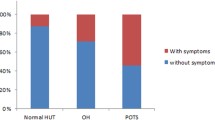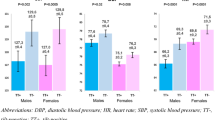Abstract
Objectives
We tested the hypothesis that detailed anthropometric and hemodynamic measurements predict orthostatic tolerance in neurally mediated syncope patients. In addition, we tested whether orthostatic tolerance is related to syncope frequency in real life.
Background
Earlier studies in patients with neurally mediated syncope suggested that orthostatic heart rate and blood pressure responses predict the tilt table responses with high sensitivity and specificity.
Methods
We analyzed data from 157 consecutive patients (n = 100 exploratory cohort, n = 57 confirmatory cohort) with recurrent syncope in whom orthostatic tolerance was quantified as the time to (pre)syncope during head-up tilt testing combined with lower body negative pressure. We measured heart rate, brachial blood pressure, cardiac stroke volume, heart rate and blood pressure variability, and spontaneous baroreflex sensitivity supine and early during head-up tilt.
Results
The orthostatic heart rate increase showed the strongest correlation with orthostatic tolerance. The best multivariate model including age, supine diastolic blood pressure, supine blood pressure variability, as well as tilt-induced changes in diastolic blood pressure and heart rate explained no more that 40% of the variability in orthostatic tolerance. The model failed to predict orthostatic tolerance in the confirmatory cohort. Frequency or number of free-living syncopal episodes were only weakly related to orthostatic tolerance.
Conclusions
In patients with neurally mediated syncope, orthostatic tolerance in the clinical laboratory is difficult to predict with a wide range of anthropometric and cardiovascular measurements and correlates poorly with syncope occurrence in real life.


Similar content being viewed by others
References
Anonymous (1996) Heart rate variability: standards of measurement, physiological interpretation and clinical use. Task Force of the European Society of Cardiology and the North American Society of Pacing and Electrophysiology. Circulation 93:1043–1065
Bellard E, Fortrat JO, Vielle B, Dupuis JM, Victor J, Leftheriotis G (2001) Early predictive indexes of head-up tilt table testing outcomes utilizing heart rate and arterial pressure changes. Am J Cardiol 88:903–906, A8
Bertinieri G, Di Rienzo M, Cavallazzi A, Ferrari AU, Pedotti A, Mancia G (1985) A new approach to analysis of the arterial baroreflex. J Hypertens Suppl 3:S79–S81
Cohen MA, Taylor JA (2002) Short-term cardiovascular oscillations in man: measuring and modelling the physiologies. J Physiol 542:669–683
Colman N, Nahm K, Ganzeboom KS, Shen WK, Reitsma J, Linzer M, Wieling W, Kaufmann H (2004) Epidemiology of reflex syncope. Clin Auton Res 14:9–17
Del Rosso A, Ungar A, Maggi R, Giada F, Petix NR, De Santo T, Menozzi C, Brignole M (2008) Clinical predictors of cardiac syncope at initial evaluation in patients referred urgently to a general hospital: the EGSYS score. Heart 94:1620–1626
El-Bedawi KM, Hainsworth R (1994) Combined head-up tilt and lower body suction: a test of orthostatic tolerance. Clin Auton Res 4:41–47
Evrengul H, Tavli V, Evrengul H, Tavli T, Dursunoglu D (2006) Spectral and time-domain analyses of heart-rate variability during head-upright tilt-table testing in children with neurally mediated syncope. Pediatr Cardiol 27:670–678
Fu Q, Witkowski S, Levine BD (2004) Vasoconstrictor reserve and sympathetic neural control of orthostasis. Circulation 110:2931–2937
Fuca G, Dinelli M, Gianfranchi L, Bressan S, Lamborghini C, Alboni P (2008) Do subjects with vasovagal syncope have subtle haemodynamic alterations during orthostatic stress? Europace 10:751–759
Furlan R, Piazza S, Dell’Orto S, Barbic F, Bianchi A, Mainardi L, Cerutti S, Pagani M, Malliani A (1998) Cardiac autonomic patterns preceding occasional vasovagal reactions in healthy humans. Circulation 98:1756–1761
Garcia AA, Lacunza RJ, Rojo Alvarez JL, Sanchez Munoz JJ, Martinez SJ, Requena CJ, Barnes J, Valdes M (2005) Early heart rate increase does not predict the result of the head-up tilt test potentiated with nitroglycerin. Rev Esp Cardiol 58:499–503
Grimm W, Wirths A, Hoffmann J, Menz V, Maisch B (1998) Heart rate variability during head-up tilt testing in patients with suspected neurally mediated syncope. Pacing Clin Electrophysiol 21:2411–2415
Gulli G, Cooper VL, Claydon V, Hainsworth R (2003) Cross-spectral analysis of cardiovascular parameters whilst supine may identify subjects with poor orthostatic tolerance. Clin Sci (Lond) 105:119–126
Hainsworth R, El-Bedawi KM (1994) Orthostatic tolerance in patients with unexplained syncope. Clin Auton Res 4:239–244
Kochiadakis GE, Rombola AT, Kanoupakis EM, Simantirakis EN, Chlouverakis GI, Vardas PE (1997) Assessment of autonomic function at rest and during tilt testing in patients with vasovagal syncope. Am Heart J 134:459–466
Kouakam C, Lacroix D, Zghal N, Logier R, Klug D, Le FP, Jarwe M, Kacet S (1999) Inadequate sympathovagal balance in response to orthostatism in patients with unexplained syncope and a positive head-up tilt test. Heart 82:312–318
Lippman N, Stein KM, Lerman BB (1995) Failure to decrease parasympathetic tone during upright tilt predicts a positive tilt-table test. Am J Cardiol 75:591–595
Ludwig DA, Convertino VA (1994) Predicting orthostatic intolerance: physics or physiology? Aviat Space Environ Med 65:404–411
Madrid AH, Moro C, Marin-Huerta E, Novo L, Mestre JL, Lage J, Ricoy E (1994) Usefulness of the RR variability in the diagnosis of neurogenic syncope. Rev Esp Cardiol 47:536–543
Mallat Z, Vicaut E, Sangare A, Verschueren J, Fontaine G, Frank R (1997) Prediction of head-up tilt test result by analysis of early heart rate variations. Circulation 96:581–584
Massin MM, Henrard V, Gerard P (2000) Heart rate variability and the outcome of head-up tilt in syncopal children. Acta Cardiol 55:163–168
Morillo CA, Klein GJ, Jones DL, Yee R (1994) Time and frequency domain analyses of heart rate variability during orthostatic stress in patients with neurally mediated syncope. Am J Cardiol 74:1258–1262
Mosqueda-Garcia R, Furlan R, Fernandez-Violante R, Desai T, Snell M, Jarai Z, Ananthram V, Robertson RM, Robertson D (1997) Sympathetic and baroreceptor reflex function in neurally mediated syncope evoked by tilt. J Clin Invest 99:2736–2744
Mosqueda-Garcia R, Furlan R, Tank J, Fernandez-Violante R (2000) The elusive pathophysiology of neurally mediated syncope. Circulation 102:2898–2906
Movahed MR (2007) Predictor of a negative tilt-table test result based on early heart rate variation in patients with a history of syncope. Am Heart Hosp J 5:247–249
Pagani M, Lombardi F, Guzzetti S, Rimoldi O, Furlan R, Pizzinelli P, Sandrone G, Malfatto G, Dell’Orto S, Piccaluga E, Turiel M, Baselli G, Cerutti S, Malliani A (1986) Power spectral analysis of heart rate and arterial pressure variabilities as a marker of sympatho-vagal interaction in man and conscious dog. Circ Res 59:178–193
Pagani M, Lucini D, Rimoldi O, Furlan R, Piazza S, Porta A, Malliani A (1996) Low and high frequency components of blood pressure variability. Ann NY Acad Sci 783:10–23
Pavy-Le Traon A, Louisy F, Vasseur-Clausen P, Güell A, Gharib C (1999) Contributory factors to orthostatic intolerance after simulated weightlessness. Clin Physiol 19:360–368
Piccirillo G, Naso C, Moise A, Lionetti M, Nocco M, Di CS, De Laurentis T, Magri D, Cacciafesta M, Marigliano V (2004) Heart rate and blood pressure variability in subjects with vasovagal syncope. Clin Sci (Lond) 107:55–61
Pitzalis M, Massari F, Guida P, Iacoviello M, Mastropasqua F, Rizzon B, Forleo C, Rizzon P (2002) Shortened head-up tilting test guided by systolic pressure reductions in neurocardiogenic syncope. Circulation 105:146–148
Pruvot E, Vesin JM, Schlaepfer J, Fromer M, Kappenberger L (1994) Autonomic imbalance assessed by heart rate variability analysis in vasovagal syncope. Pacing Clin Electrophysiol 17:2201–2206
Sheldon R, Rose S, Ritchie D, Connolly SJ, Koshman ML, Lee MA, Frenneaux M, Fisher M, Murphy W (2002) Historical criteria that distinguish syncope from seizures. J Am Coll Cardiol 40:142–148
Sheldon R, Rose S, Connolly S, Ritchie D, Koshman ML, Frenneaux M, for the Syncope Symptom Study Investigators (2006) Diagnostic criteria for vasovagal syncope based on a quantitative history. Eur Heart J 27:344–350
Sneddon JF, Counihan PJ, Bashir Y, Haywood GA, Ward DE, Camm AJ (1993) Assessment of autonomic function in patients with neurally mediated syncope: augmented cardiopulmonary baroreceptor responses to graded orthostatic stress. J Am Coll Cardiol 21:1193–1198
Sramek BB (1982) Cardiac output by electrical impedance. Med Electron 13:93–97
Stewart JM, Erb M, Sorbera C (1996) Heart rate variability and the outcome of head-up tilt in syncopal children. Pediatr Res 40:702–709
Sumiyoshi M, Nakata Y, Mineda Y, Tokano T, Yasuda M, Nakazato Y, Yamaguchi H (2000) Does an early increase in heart rate during tilting predict the results of passive tilt testing? Pacing Clin Electrophysiol 23:2046–2051
Sutton R, Petersen M, Brignole M, Raviele A, Menozzi C, Giani P (1992) Proposed classification for tilt induced vasovagal syncope. Eur J Cardiac Pacing Electrophysiol 2:180–183
Zygmunt A, Stanczyk J (2004) Heart rate variability in children with neurocardiogenic syncope. Clin Auton Res 14:99–106
Author information
Authors and Affiliations
Corresponding author
Rights and permissions
About this article
Cite this article
Schroeder, C., Tank, J., Heusser, K. et al. Orthostatic tolerance is difficult to predict in recurrent syncope patients. Clin Auton Res 21, 37–45 (2011). https://doi.org/10.1007/s10286-010-0090-6
Received:
Accepted:
Published:
Issue Date:
DOI: https://doi.org/10.1007/s10286-010-0090-6




